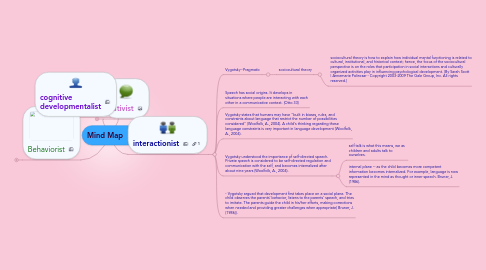
1. Behaviorist
1.1. Skinner ~ Semantic, Syntactic, Morphemic
1.1.1. If we give pleasant experiences such as rewards or praise are positive reinforces for their language. This will cause children to make desired connections between stimuli and responses.
1.1.2. When unpleasant experiences happens such as punishment are negative reinforces.This will cause children to avoid undesirable responses to stimuli.Such as if a child has speech trouble and people make fun of the child or the child is put down for saying a word wrong it will case negative reinforcement.
1.1.3. It is said much positive reinforcement does increases the rate of children learning. By being postive about the child speech the child will learn new words faster and understand what they mean.
1.1.4. Both positive and negative reinforcement can help shape the child behavior. Such as the child could become outgoing or withdrawn depending on how the child is treated when spoken. If people over look a child miss saying a word, then the child will feel better, if the child is always told to say the word over again to they say it right they child may never use the word again only to find a word they can say mean the samething.
1.1.5. Also intermittent reinforcement contributes to longer retention of what the child has been taught in the class or at home.
1.1.6. With lack of some reinforcement would also shape a child behavior. When children receive no judgement of their behavior, A lot of times children will often change their behaviors/language until the child receive some kind of reinforcement from an adult. If the child always miss say a word or many words and no one bother to help the child, then the way the child talks may stay with the child forever. It always best to tend to the child needs so the child can have a brighter future when it comes to language.
1.2. The behaviorist perspective emphasizes the role of “nurture” and considers learning to occur based on the stimuli, responses, and reinforcements that occur in the environment.
2. nativist
2.1. Chomsky. Syntactic
2.1.1. The nativist perspective emphasizes inborn or innate human capabilities (i.e., “nature”) as being responsible for language development (Otto 27)
2.1.2. In the nativist perspective, children learn language by discovering the structure of their language (Cairns, 1996) (Otto 29)
2.1.3. children's literature should be read to children so that they can develop and test hypotheses about how language is used to communicate. (Otto 29-30)
2.1.4. children's literature should be read to children so that they can develop and test hypotheses about how language is used to communicate. (Otto 29-30)
2.1.5. Drawing and writing is also a great idea for children to learn language well. It helps them become familial with the language this is good with the child first language and second language which helps them learn the second language much faster.
2.2. The nativist and the cognitive developmentalist perspectives emphasize the contributions of “nature,” (Otto 27)
3. cognitive developmentalist
3.1. piaget ~ Semantic/Morphemic
3.1.1. Has four stages of development such as sensorimotor, preoperational, concrete operations, and formal operations.
3.2. he emphasis of this perspective is that language is acquired as maturation occurs and cognitive competencies develop. Whereas the nativist perspective emphasizes the inborn language mechanism, the cognitive developmental perspective assumes that cognitive development is a “prerequisite and foundation for language learning” (Karmiloff & Karmiloff-Smith, 2001, p. 5) (Otto 30)
3.3. One of the important aspect of the preoperational stage is the acquisition of the skill of conservation for children. They now understand and able to talk back and know their views are not the same as others. Still they are not able to think backwards due to the young age the child might be.
3.4. Use actions and verbal instruction when you are wanting the child to do something.
3.5. Open end questions for letting the child think and answer you.
3.5.1. Story telling is a way for teacher to get students to talk about the story. Same as using questions that are open end and ask what happens to the people in the book when you close it. See if they can come up with their own happy ending to the story.
4. interactionist
4.1. Vygotsky~Pragmatic
4.1.1. sociocultural theory
4.1.1.1. sociocultural theory is how to explain how individual mental functioning is related to cultural, institutional, and historical context; hence, the focus of the sociocultural perspective is on the roles that participation in social interactions and culturally organized activities play in influencing psychological development. (By Sarah Scott | Annemarie Palincsar - Copyright 2003-2009 The Gale Group, Inc. All rights reserved.)
4.2. Speech has social origins. It develops in situations where people are interacting with each other in a communicative context. (Otto 33)
4.3. Vygotsky states that humans may have "built in biases, rules, and constraints about language that restrict the number of possibilities considered" (Woolfolk, A., 2004). A child's thinking regarding these language constraints is very important in language development (Woolfolk, A., 2004).
4.4. Vygotsky understood the importance of self-directed speech. Private speech is considered to be self-directed regulation and communication with the self, and becomes internalized after about nine years (Woolfolk, A., 2004).
4.4.1. self talk is what this means, we as children and adults talk to ourselves.
4.4.2. internal plane -- as the child becomes more competent information becomes internalized. For example, language is now represented in the mind as thought or inner speech. Bruner, J. (1986).
